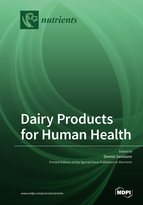Dairy Products for Human Health
A special issue of Nutrients (ISSN 2072-6643). This special issue belongs to the section "Nutrition and Public Health".
Deadline for manuscript submissions: closed (31 December 2020) | Viewed by 108556
Special Issue Editor
Interests: prebiotics; biotechnology; human nutrition; milk; dairy; probiotics
Special Issues, Collections and Topics in MDPI journals
Special Issue Information
Dear Colleagues,
Consumption of dairy foods has changed dramatically over the past sixty years in the United States, with much less fluid milk consumed, and increased consumption of cheeses and yogurts. Coffee, sugar-containing beverages, and plant-based milks have replaced much of the fluid milk consumption in the diet of Americans. At the same time, growth in both the international dairy industry, and global consumption of dairy foods has been substantial. Dairy foods are under considerable scrutiny, with concerns for the environment, and the biological effects of dairy components, including protein fractions, lipids, lactose, and other nutrients. At the same time, the high nutrient content in dairy foods, including protein, calcium, potassium, and riboflavin, make them a significant contributor to diet quality. Dairy product consumption can influence gut health, weight, cardiometabolic health, diabetes, bone mineral density, and many types of cancers, etc.
This Special Issue of Nutrients seeks new scientific evidence that addresses health concerns and opportunities related to dairy product consumption. Dairy products play an important role in the diet quality and are associated with human health and disease. Our goal is to provide a stronger base of scientific information for the consumer, and professionals who advise them on diet. Both professionals and consumers are undoubtedly confused about the value and risks of dairy foods in the diet due to limited science behind many of the claims.
Dr. Dennis Savaiano
Guest Editor
Manuscript Submission Information
Manuscripts should be submitted online at www.mdpi.com by registering and logging in to this website. Once you are registered, click here to go to the submission form. Manuscripts can be submitted until the deadline. All submissions that pass pre-check are peer-reviewed. Accepted papers will be published continuously in the journal (as soon as accepted) and will be listed together on the special issue website. Research articles, review articles as well as short communications are invited. For planned papers, a title and short abstract (about 100 words) can be sent to the Editorial Office for announcement on this website.
Submitted manuscripts should not have been published previously, nor be under consideration for publication elsewhere (except conference proceedings papers). All manuscripts are thoroughly refereed through a single-blind peer-review process. A guide for authors and other relevant information for submission of manuscripts is available on the Instructions for Authors page. Nutrients is an international peer-reviewed open access semimonthly journal published by MDPI.
Please visit the Instructions for Authors page before submitting a manuscript. The Article Processing Charge (APC) for publication in this open access journal is 2900 CHF (Swiss Francs). Submitted papers should be well formatted and use good English. Authors may use MDPI's English editing service prior to publication or during author revisions.
Keywords
- Dairy products
- Dairy
- Milk
- Cheese
- Yogurt
- Obesity
- Cardiovascular disease
- Metabolic syndrome
- Cancer
- Type 2 diabetes
- Bone
- Mental health
- Neurodegenerative disease







